Is Your Dog Losing Hair?
Is your dog is losing hair in patches and scabs? This can be a sign of an underlying health issue that needs attention. Alopecia, the medical term for hair loss in dogs, can occur for a variety of reasons ranging from hormonal imbalances to allergies. A dog losing hair in patches and scabs is commonly caused by parasites like fleas and mites, fungal or bacterial infections, or allergic reactions. These conditions can lead to intense itching, causing excessive scratching, which in turn results in scabs and bald spots in dogs.
With patience, a proper diagnosis and a holistic approach to treatment (combining natural dog hair loss treatment with conventional veterinary care), most hair loss in dogs can be reversed. After your veterinarian identifies the underlying cause of your dog's hair loss, making dietary changes and using natural remedies can halt further hair loss and promote the growth of a healthy, shiny coat.
5 Common Reasons For Hair Loss In Dogs
1) Parasites - Infestations of parasites such as fleas, ticks and mites can be the reason your dog is losing hair. Hair loss might occur around the ears, eyes, abdomen, tail or back end, causing inflammation, itching and redness. Parasites can thin the coat due to scratching and irritation. Dogs may also develop flea allergies in which the pet develops an allergic reaction to the flea bite. Working with your veterinarian to eliminate the parasites is the first step. Once fleas and parasites are ruled out, look at your dog's diet to identify possible allergens. Feeding a high-moisture diet and adding supplements like Amazing Omegas and Power Probiotic can help heal and soothe your dog's inflammation and irritation.
 2) Allergies - Food and environmental allergies can cause dogs to itch and scratch, resulting in bald spots and hair loss. Your dog may develop red, gooey areas (referred to as hot spots) due to constant chewing and licking. Hot spots can spread rapidly, so it's important to see a veterinarian for treatment. Vets have medicated powders, usually including antibiotics and steroids, which can quickly get hot spots under control. For long-term relief, it's essential to prevent future flareups by changing your dog's diet and using a few home remedies to reduce allergic itching and scratching. AllerEaze For Pets, Power Probiotic, Olive Leaf Extract For Pets, and K9 Yeast Defense can help provide fast relief from allergy symptoms and help reduce allergy-induced bald spots in dogs.
3) Dry Skin - Dogs can lose hair due to dry skin resulting from a lack of essential fatty acids in their diet. Dogs with dry coats often have white, dandruff flakes and are especially itchy. Fish and fish oil can give dogs a beautiful, lustrous coat by moisturizing a dry coat from the inside out. Fish oil contains essential fatty acids called Omega 3s, which dogs cannot produce themselves. Many pet foods are lacking in Omega-3 fatty acids. EFAs (essential fatty acids) are scientifically proven to help with allergies and skin problems. While topical rinses and medicated shampoos may help somewhat, giving your dog a highly therapeutic fish oil along with a grain-free, low carbohydrate diet can improve your dog's coat quickly. 2) Allergies - Food and environmental allergies can cause dogs to itch and scratch, resulting in bald spots and hair loss. Your dog may develop red, gooey areas (referred to as hot spots) due to constant chewing and licking. Hot spots can spread rapidly, so it's important to see a veterinarian for treatment. Vets have medicated powders, usually including antibiotics and steroids, which can quickly get hot spots under control. For long-term relief, it's essential to prevent future flareups by changing your dog's diet and using a few home remedies to reduce allergic itching and scratching. AllerEaze For Pets, Power Probiotic, Olive Leaf Extract For Pets, and K9 Yeast Defense can help provide fast relief from allergy symptoms and help reduce allergy-induced bald spots in dogs.
3) Dry Skin - Dogs can lose hair due to dry skin resulting from a lack of essential fatty acids in their diet. Dogs with dry coats often have white, dandruff flakes and are especially itchy. Fish and fish oil can give dogs a beautiful, lustrous coat by moisturizing a dry coat from the inside out. Fish oil contains essential fatty acids called Omega 3s, which dogs cannot produce themselves. Many pet foods are lacking in Omega-3 fatty acids. EFAs (essential fatty acids) are scientifically proven to help with allergies and skin problems. While topical rinses and medicated shampoos may help somewhat, giving your dog a highly therapeutic fish oil along with a grain-free, low carbohydrate diet can improve your dog's coat quickly.
Tango
"I had tried several other brands of fish oil for my Yorkie, Tango. His coat continued to look dry while using the other brands. I started using Amazing Omegas and seriously within a few DAYS I noticed a new sheen and luster on his coat. I believe that the difference is the uncompromising quality of this product. The first time I opened the bottle, I immediately noticed the fresh smell of this oil. I also added Power Probiotic to Tango's regimen. Tango’s groomer, who is an expert on canine coats, comments regularly about the health and beauty of his coat. We love these products and would highly recommend them."
Barber Family, California
4) Fungal or Bacterial Infections - Bacterial and fungal infections are common in pets, and dogs may have both at the same time. The most common type of fungal infection is yeast (candida). Bacterial skin infections usually occur when your pet scratches and breaks the skin, allowing bacteria to infect the wound. Many pets develop yeast infections after using antibiotics for a bacterial infection, so treating both simultaneously is often effective. Dogs with yeast infections on the skin typically have chronic ear infections too.
With bacterial or fungal infections, you may notice your dog scratching, biting, shaking its head, licking the genitals constantly, or you may smell a cheesy odor (even after a bath). When dogs continue to lick and chew in one area, it can cause hot spots and open wounds. These areas lose hair and become red and inflamed. Hot spots are painful and can spread quickly, so if you notice one, please take your pet to the veterinarian right away. In most cases, your veterinarian will need to prescribe antibiotics to kill the bacteria. It is important to use immune support supplements along with antibiotics. Using Power Probiotic for Pets, K9 Yeast Defense, Olive Leaf Extract For Pets and NotaSAN Capsules can help to promote the growth of friendly bacteria while helping to prevent future infections.
Maestro - French Bulldog Finds Relief From Scratching and Hair Loss
"Our sweet French Bulldog Maestro was scratching his face and tearing his fur out. He is very sensitive and we didn't want to keep giving him prescription medications. Benadryl would just knock him out and we wanted our doggie to feel better. We tried several diet changes and a few itch-relief products from other brands but nothing worked. Then, we found Ask Ariel. I am happy to report that after using the Amazing Omegas, K9 Digestive Enzymes, Power Probiotic, K9 Yeast Defense, ProAller and QUENT Drops, Maestro started to get better right away. He loves the Amazing Omegas on his food! A patch of fur that he kept chewing on is finally growing back. Thanks for the diet tips too. We are very happy we found Ask Ariel."
Amy, California
 5) Endocrine Conditions Endocrine conditions can cause skin and hair changes in dogs. Hypothyroidism is a hormone imbalance where the thyroid produces too little thyroxine, the hormone that controls metabolism. Hypothyroidism can cause dry, brittle hair and skin issues.
5) Endocrine Conditions Endocrine conditions can cause skin and hair changes in dogs. Hypothyroidism is a hormone imbalance where the thyroid produces too little thyroxine, the hormone that controls metabolism. Hypothyroidism can cause dry, brittle hair and skin issues.
In Cushing’s disease the adrenal glands produce too much cortisol, the fight-or-flight hormone, that regulates stress and appetite. Excessive cortisol production weakens hair follicles and alters skin structure, leading to thinning or patchy hair. One of the hallmark symptoms of Cushing's disease is hair loss on the tail in dogs. Dogs with Cushing's may also exhibit skin changes like darkening or thickening. Alopecia, also called black skin disease, is a sex hormone imbalance that causes symmetrical hair loss.
Dogs with these endocrine disorders may have thinning skin and skin discoloration. Hormonal conditions can be serious, and it's essential to work with your veterinarian to determine the best course of action. Once a diagnosis is made, supportive supplements such as the
Liver Support Kit and Canine Cushing's Support can be helpful.
How Hair Loss Varies Among Different Dog Breeds
Hair loss in dogs can vary significantly depending on their breed, coat type, genetic predispositions, and any other health issues. Understanding these factors can help pet owners manage hair loss more effectively.
- Coat Type
Double-Coated Breeds - Dogs with double coats (e.g., Siberian Huskies, Golden Retrievers) may experience seasonal shedding, where the undercoat sheds heavily in spring and fall.
Single-Coated Breeds - Dogs with single coats (e.g., Poodles, Shih Tzus) tend to shed less overall but may be prone to hair loss from skin conditions.
- Genetic Predispositions - Some breeds have genetic predispositions to specific types of alopecia (hair loss). For example, Dachshunds and Chihuahuas are prone to Pattern Baldness, which is similar to male pattern baldness in humans.
- Health Issues - Certain breeds are more susceptible to health issues that cause hair loss. For example, Cocker Spaniels are prone to hypothyroidism, while Bulldogs often suffer from skin infections.
Common Hair Loss Conditions By Dog Breed
Boxers - Prone to Seasonal Flank Alopecia, which causes hair loss on the flanks, usually in the fall or winter.
Bulldogs - Frequently suffer from skin infections due to their skin folds, which can lead to hair loss.
Chihuahuas - Prone to Pattern Baldness, especially on the ears, chest, and belly.
Cocker Spaniels - Prone to hypothyroidism and seborrhea, both of which can cause significant hair loss.
Dachshunds - Also susceptible to Pattern Baldness, typically affecting the same areas as Chihuahuas.
Doberman Pinschers - Commonly experience Color Dilution Alopecia, a condition that affects dogs with a blue or fawn coat, leading to hair thinning and loss.
Golden Retrievers - Susceptible to hypothyroidism, which can lead to hair thinning and loss, especially on the trunk.
Poodles - Can experience Alopecia X, also known as Black Skin Disease, where hair loss and darkened skin occur.
Siberian Huskies and Alaskan Malamutes - Prone to Zinc-Responsive Dermatosis, causing hair loss and scaling, particularly around the face and paws.
Yorkshire Terriers - Can suffer from endocrine disorders like Cushing's disease, leading to hair loss.
The Connection Between Diet & Hair Loss in Dogs
Nutrition plays an important role in maintaining a dog's healthy coat and overall well-being. High-quality proteins are the building blocks of healthy fur, as they supply the necessary amino acids for hair follicle growth and repair. Foods like lean meats, fish, and eggs are excellent sources of protein that can help maintain a glossy and thick coat. Omega-3 fatty acids are vital for a dog's coat health. These essential fatty acids, found in fish oil, flaxseed, and certain types of meat, help reduce inflammation, support skin health, and add luster to the coat.
Vitamins and minerals also play significant roles: Vitamin E acts as an antioxidant to protect skin cells from damage, Vitamin A supports cell growth and repair, and B vitamins help convert food into energy and maintain healthy skin and hair. Zinc is another critical mineral, as it promotes hair follicle health and prevents hair loss. Incorporating a variety of these nutrients into a dog's diet through high-quality pet food and supplements ensures a healthy, shiny coat and can help mitigate issues like dryness, dandruff, and excessive shedding.
Foods Rich in Vitamin E - Sunflower seeds (or oil), spinach, broccoli, olive oil.
Foods Rich in Zinc - Beef, lamb, salmon, pumpkin seeds.
Foods Rich in Vitamin A - Carrots, sweet potatoes, liver, kale, pumpkin, cod liver oil.*
*Cod liver oil is rich in Vitamin A, Vitamin D, and Omega-3 fatty acids. It supports healthy skin and coat, boosts the immune system, and promotes joint health. Just a small amount can provide significant nutritional benefits, but it should be used cautiously to avoid Vitamin A toxicity.
Ask Ariel will include healthy diet tips for your dog on the packing slip that comes with your order.
Dog Hair Loss Home Remedies
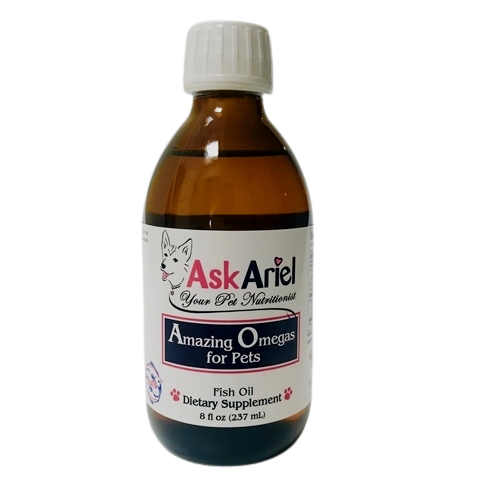 Amazing Omegas - Amazing Omegas for Pets is a research-backed, concentrated therapeutic fish oil providing a powerhouse of omega-3 fatty acids in just a few drops. These omega-3 fatty acids can give your dog a lustrous, beautiful coat, help reduce inflammation and fight allergies. Many fish oil products for pets do not contain bioavailable omega-3 fatty acids, so pet owners may use them without success. The word "bioavailable" means that the fish oil is in its natural state - in a form that your dog's body can recognize as food and metabolize. Amazing Omegas contains fish oil naturally processed from anchovies, sardines and mackerel, making it highly bioavailable for best absorption. It’s packed in glass bottles to prevent toxin leakage from plastic into the oil. Amazing Omegas is recommended by veterinarians nationwide because of its high purity and quality. Amazing Omegas - Amazing Omegas for Pets is a research-backed, concentrated therapeutic fish oil providing a powerhouse of omega-3 fatty acids in just a few drops. These omega-3 fatty acids can give your dog a lustrous, beautiful coat, help reduce inflammation and fight allergies. Many fish oil products for pets do not contain bioavailable omega-3 fatty acids, so pet owners may use them without success. The word "bioavailable" means that the fish oil is in its natural state - in a form that your dog's body can recognize as food and metabolize. Amazing Omegas contains fish oil naturally processed from anchovies, sardines and mackerel, making it highly bioavailable for best absorption. It’s packed in glass bottles to prevent toxin leakage from plastic into the oil. Amazing Omegas is recommended by veterinarians nationwide because of its high purity and quality.
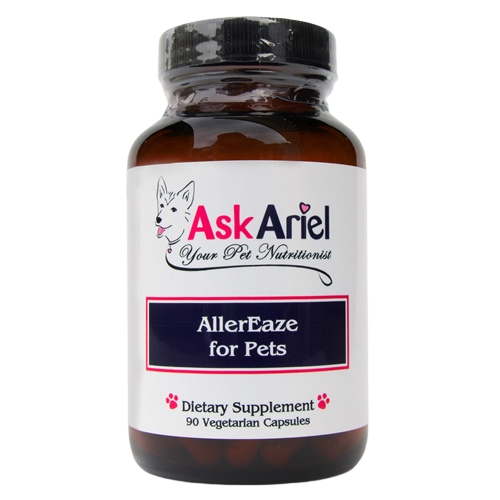 AllerEaze - All-natural AllerEaze is a leading allergy product for dogs and is one of the best home remedies for dog itching and losing hair. AllerEaze contains scientifically proven quercetin and nettles to provide natural relief for your dog. Quercetin suppresses the histamine reaction and blocks inflammatory enzymes to reduce swelling, scratching, and itching. Many holistic veterinarians refer to it as a natural “Benadryl.” Nettle leaf has anti-inflammatory properties that help with allergies. AllerEaze helps take the edge off allergy symptoms such as itchy, scratching, redness and inflammation. It is a safe, natural alternative to Apoquel. AllerEaze works best when combined with Power Probiotic. AllerEaze - All-natural AllerEaze is a leading allergy product for dogs and is one of the best home remedies for dog itching and losing hair. AllerEaze contains scientifically proven quercetin and nettles to provide natural relief for your dog. Quercetin suppresses the histamine reaction and blocks inflammatory enzymes to reduce swelling, scratching, and itching. Many holistic veterinarians refer to it as a natural “Benadryl.” Nettle leaf has anti-inflammatory properties that help with allergies. AllerEaze helps take the edge off allergy symptoms such as itchy, scratching, redness and inflammation. It is a safe, natural alternative to Apoquel. AllerEaze works best when combined with Power Probiotic.
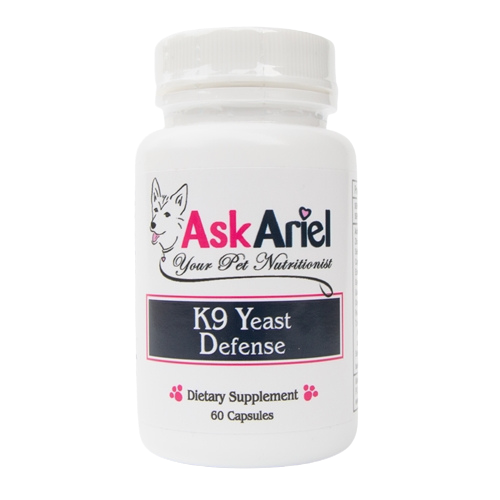 K9 Yeast Defense - Many dogs constantly itch due to an underlying yeast condition. If your dog has had ear infections or a smelly odor, especially on the paws, then use K9 Yeast Defense in conjunction with allergy products. K9 Yeast Defense contains natural antifungal ingredients such as pau d'arco, caprylic acid and oregano oil to help stop doggie odor, chronic ear infections, licking at the groin, and scratching at the ears. Allergies, food, antibiotics and steroid use can all contribute to yeast infections in dogs. Our K9 Yeast Defense is a safe way to get rid of yeast infection symptoms and support your pet's immune system. Since yeast and bacterial growth go hand in hand, it's best to use K9 Yeast Defense along with NotaSAN Capsules and Power Probiotic. K9 Yeast Defense - Many dogs constantly itch due to an underlying yeast condition. If your dog has had ear infections or a smelly odor, especially on the paws, then use K9 Yeast Defense in conjunction with allergy products. K9 Yeast Defense contains natural antifungal ingredients such as pau d'arco, caprylic acid and oregano oil to help stop doggie odor, chronic ear infections, licking at the groin, and scratching at the ears. Allergies, food, antibiotics and steroid use can all contribute to yeast infections in dogs. Our K9 Yeast Defense is a safe way to get rid of yeast infection symptoms and support your pet's immune system. Since yeast and bacterial growth go hand in hand, it's best to use K9 Yeast Defense along with NotaSAN Capsules and Power Probiotic.
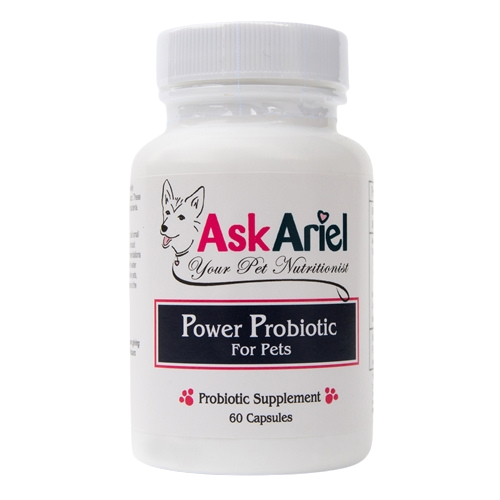 Power Probiotic - Controlling allergies starts with good digestion. The skin is an elimination organ, and so using Power Probiotic is your pet's first defense toward building a strong immune system. Power Probiotic is the best probiotic for pets! Backed by scientific research, this powerful multi-strain probiotic supplement promotes the growth of good, friendly bacteria which boosts your pet's immune system. Because it fights infection and yeast, Power Probiotic is essential if your pet has taken antibiotics. Research shows probiotic supplements can reduce skin sensitivity and promote the balance of healthy bacteria on the skin to reduce inflammation. Safe and natural. Power Probiotic is especially helpful for dogs with skin problems, yeast and allergies. Many pets love the taste of the Power Probiotic! Power Probiotic - Controlling allergies starts with good digestion. The skin is an elimination organ, and so using Power Probiotic is your pet's first defense toward building a strong immune system. Power Probiotic is the best probiotic for pets! Backed by scientific research, this powerful multi-strain probiotic supplement promotes the growth of good, friendly bacteria which boosts your pet's immune system. Because it fights infection and yeast, Power Probiotic is essential if your pet has taken antibiotics. Research shows probiotic supplements can reduce skin sensitivity and promote the balance of healthy bacteria on the skin to reduce inflammation. Safe and natural. Power Probiotic is especially helpful for dogs with skin problems, yeast and allergies. Many pets love the taste of the Power Probiotic!
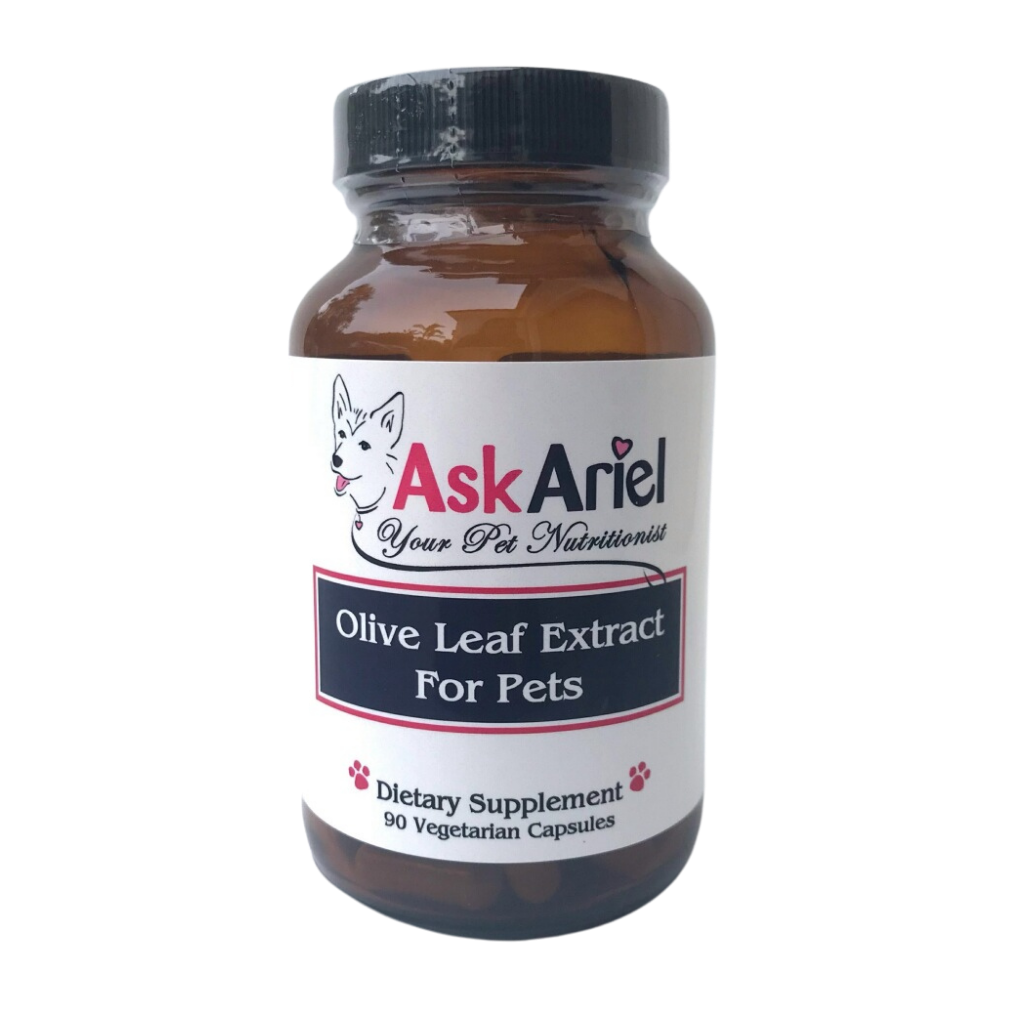 Olive Leaf Extract - Olive Leaf Extract for Pets is a powerful antiviral, antibacterial, and antifungal supplement that supports a healthy immune system. It is a single- ingredient formula that is helpful for dogs with allergies, ear infections, skin infections and yeast overgrowth (tear-stained eyes, ear discharge, cheesy smell, licking groin, yeasty paws). Olive Leaf Extract is a natural alternative to antibiotics prescribed for skin conditions. Its active ingredient, oleuropein, helps fight against pathogens while causing no harm to healthy bacteria in your dog's gut and mucous membranes. Olive Leaf Extract has antioxidant properties that help relieve the irritation and inflammation caused by skin infections. Olive Leaf Extract - Olive Leaf Extract for Pets is a powerful antiviral, antibacterial, and antifungal supplement that supports a healthy immune system. It is a single- ingredient formula that is helpful for dogs with allergies, ear infections, skin infections and yeast overgrowth (tear-stained eyes, ear discharge, cheesy smell, licking groin, yeasty paws). Olive Leaf Extract is a natural alternative to antibiotics prescribed for skin conditions. Its active ingredient, oleuropein, helps fight against pathogens while causing no harm to healthy bacteria in your dog's gut and mucous membranes. Olive Leaf Extract has antioxidant properties that help relieve the irritation and inflammation caused by skin infections.
|